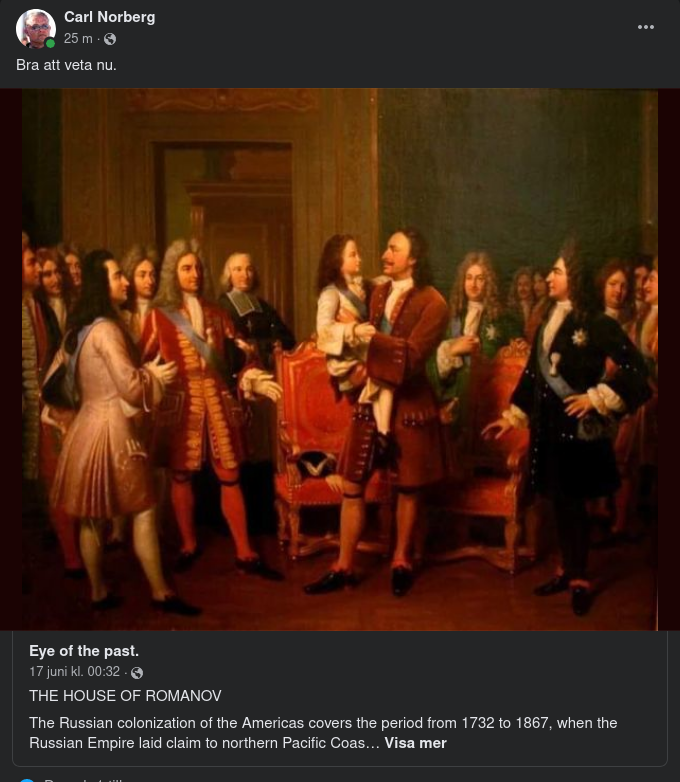Bra Historievetande
2022-06-19

THE HOUSE OF ROMANOV
The Russian colonization of the Americas covers the period from 1732 to 1867, when the Russian Empire laid claim to northern Pacific Coast territories in the Americas...
Russian colonial possessions in the Americas are collectively known as Russian America...
Russian America was the name of the Russian colonial possessions in North America from 1733 to 1867...
Its capital was Novo-Arkhangelsk (New Arkhangelsk), which is now Sitka, Alaska, United States...
Settlements spanned parts of what are now the U.S. states of California, Alaska and three forts in Hawaii...
Which is where the ERRONEOUS narrative regarding the so called “Kingdom of Hawaii” stems from...
The Russian Empire was an empire that extended across Eurasia and North America from 1721, following the end of the Great Northern War, until the Republic was proclaimed by the Provisional Government that took power after the February Revolution of 1917...
The third-largest empire in history, at its greatest extent stretching over three continents, Europe, Asia, and North America, the Russian Empire was surpassed in size only by the British and Mongol empires...
The House of Romanov ruled the Russian Empire from 1721 until 1762...
Its matrilineal branch of patrilineal German descent, the House of Holstein-Gottorp-Romanov, ruled from 1762 until the end of the empire...
At the beginning of the 19th century, the Russian Empire extended from the Arctic Ocean in the north to the Black Sea in the south, from the Baltic Sea on the west into Alaska and Northern California in America on the east...
Much of Russia's expansion occurred in the 17th century, culminating in the first Russian colonization of the Pacific...
With 125.6 million subjects registered by the 1897 census, it had the third-largest population in the world at the time, after Qing China and India...
Economically, the empire was predominantly agricultural, with low productivity on large estates worked by Russian peasants, known as serfs, (Caucasian Slavs / slaves) who were tied to the land in a feudal arrangement...
The serfs (Caucasian slaves) were freed in 1861, but the landowning aristocratic class (so called black Romanovs) kept control....
The House of Romanov was the reigning imperial house of Russia from 1613 to 1917...
Paul I was murdered in his palace in Saint Petersburg in 1801...
Alexander I succeeded him on the throne and later died without leaving a son...
His brother, crowned Nicholas I, succeeded him on the throne...
Alexander II, son of Nicholas I, became the next Russian emperor in 1855, in the midst of the Crimean War...
By developing the army, giving some freedom to Finland, and freeing the serfs (Caucasian Slavs / slaves) in 1861 he gained much popular support...
The February Revolution known in Soviet historiography as the February Bourgeois Democratic Revolution and sometimes as the March Revolution, was the first of two revolutions which took place in Russia in 1917...
The main events of the revolution took place in and near Petrograd (present-day Saint Petersburg), the then-capital of Russia, where long-standing discontent with the monarchy erupted into mass protests against food rationing...
Revolutionary activity lasted about eight days, involving mass demonstrations and violent armed clashes with police and gendarmes, the last loyal forces of the Russian monarchy...
On February 27, mutinous Russian Army forces sided with the revolutionaries...
Three days later Tsar Nicholas II abdicated, ending Romanov dynastic rule and the Russian Empire...
The February Revolution of 1917 resulted in the abdication of Nicholas II...
After the February Revolution, Nicholas II and his family were placed under house arrest in the Alexander Palace...
While several members of the imperial family managed to stay on good terms with the Provisional Government, and were eventually able to leave Russia, Nicholas II and his family were sent into exile in the Siberian town of Tobolsk by Alexander Kerensky in August 1917...
On the night of July 17, 1918, Bolshevik authorities acting on Yakov Sverdlov's orders in Moscow and led locally by Filip Goloschekin and Yakov Yurovsky, shot and killed Nicholas II, and his immediate family in the Ipatiev House's cellar...
Charles Graham
Visa ditt stöd till det informationsarbete Carl genomför
Patreon
Swish

Scanna QR eller skicka till 076-118 25 68. Mottagare är Caroline Norberg.
